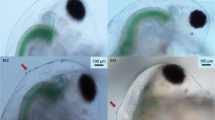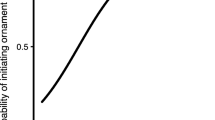Summary
It has been proposed that morphological defenses against predation have demographic costs. We measured the cost of a predator-induced morphological defense, using predaceous phantom midge larvae Chaoborus americanus (Insecta, Diptera) and the prey species Daphnia pulex (Crustacea, Cladocera). The induced defense is a neck tooth (and other pleiotropic structures) developed in juvenile D. pulex in the presence of C. americanus. Laboratory life table experiments, in the absence of predation, indicated the population growth rate of typical D. pulex was 11% to 39% greater than that of D. pulex exposed to C. americanus extract, or C. americanus-conditioned water. The reduction in population growth rate was most frequently associated with an increase in the time between birth and first reproduction. Induced individuals required twenty more hours at 23°C, and twenty five more hours at 20°C, to develop to the age of first reproduction. Under limiting food conditions age-specific survivorship and the number of offspring produced per female by the induced form were reduced relative to the typical form. As a result, the difference in population growth rates among forms was greater at the low food level as indicated by a highly significant food by form interaction effect. In addition to neck teeth and lowered reproductive rates, the offspring of induced form individuals had significantly longer tail-spines (7.2–7.5%), and primiparous adults from the induction treatment were significantly shorter than controls (3–8%).
Similar content being viewed by others
References
Bold HC, Wynne MJ (1978) Introduction to the Algae: Structure and Reproduction, Prentice Hall, Englewood Cliffs, NJ
Crow JF (1986) Basic Concepts in Population, Quantitative, and Evolutionary Genetics, Freeman, New York, NY
Dodson SI (1974) Adaptive change in plankton morphology in response to size selective predation: A new hypothesis of cyclomorphosis. Limnol Oceanogr 19:721–729
Dodson SI (1988) The ecological role of chemical stimuli for the zooplankton: Predator-avoidance behavior in Daphnia. Limnol Oceanogr 33:1431–1439
Dodson SI (1989a) Predator-induced reaction norms. Bioscience 39:447–452
Dodson SI (1989b) The ecological role of chemical stimuli for the zooplankton: predator-induced morphology in Daphnia. Oecologia 78:361–367
Fisher RA (1958) The Genetical Theory of Natural Selection, Dover, New York, NY
Grant JWG, Bayly AE (1981) Predator induction of crests in morphs of the Daphnia carinata King complex. Limnol Oceanogr 26:201–218
Harvell CD (1984) Predator-induced defenses in a marine bryozoan. Science 224:1357–1359
Havel JE (1985) Cyclomorphosis of Daphnia pulex spined morphs. Limnol Oceanogr 30(4):853–861
Havel JE (1987) Predator-induced defenses: A review. In Kerfoot WC, Sih A (eds) Predation: Direct and Indirect Impacts on Aquatic Communities, University Press of New England, Hanover, NH, pp 263–278
Havel JE, Dodson SI (1984) Chaoborus predation on typical and spined morphs of Daphnia pulex: Behavioral observations. Limnol Oceanogr 29:487–494
Havel JE, Dodson SI (1987) Reproductive costs of Chaoborus-induced polymorphism in Daphnia pulex. Hydrobiologia 150:273–281
Hebert PDN (1978) The adaptive significance of cyclomorphosis in Daphnia: more possibilities. Freshw Biology 8:313–320
Hebert PDN, Grewe PM (1985) Chaoborus-induced shifts in the morphology of Daphnia ambigua. Limnol Oceanogr 30:1291–1297
Johnsen GH, Jakobsen PJ (1987) The effect of food limitation on vertical migration in Daphnia longispina. Limnol Oceanogr 32:873–880
Kerfoot WC (1978) Combat between predatory copepods and their prey: Cyclops, Epischura, and Bosmina. Limnol Oceanogr 23:1089–1102
Kerfoot WC, Peterson C (1979) Ecological interactions and evolutionary arguments: Investigations with predatory copepods and Bosmina. fortschr Zool 25:159–196
Kerfoot WC, Levitan C, DeMott WR (1988) Daphnia-phytoplankton interactions: Density-dependent shifts in resource quality. Ecology 69:1806–1825
Krueger DA, Dodson SI (1981) Embryological induction and predation ecology in Daphnia pulex. Limnol Oceanogr 26:219–223
Lampert W (1987) Vertical migration of freshwater zooplankton: Indirect effects of vertebrate predator on algal communities. In: Kerfoot WC, Sih A (eds) Predation: Direct and Indirect Impacts on Aquatic Communities, University Press of New England, Hanover, NH, pp 291–299
Lenski RE, Service PM (1982) The statistical analysis of population growth rates calculated from schedules of survivorship and fecundity. Ecology 63:655–662
Leucke C, Litt AH (1987) Effects of predation by Chaoborus flavicans on crustacean zooplankton of Lake Lenore, Washington. Freshwater Biology 18:185–192
Lively C (1986) Canalization versus developmental conversion in a spatially variable environment. Am Nat 128:561–572
Lynch M, Weider LJ, Lampert W (1986) Measurement of the carbon balance in Daphnia. Limnol Oceanogr 31:17–33
O'Brien WJ, Vinyard GL (1978) Polymorphism and predation: The effect of invertebrate predation on the distribution of two varieties of Daphnia carinata in South India ponds. Limnol Oceanogr 23:452–460
Parejko KS, Dodson SI (1990) Progress towards characterization of a predator-prey kairomone: Daphnia pulex and Chaoborus americanus. Hydrobiologia (in press)
Riessen HP (1984) The other side of cyclomorphosis: Why Daphnia lose their helmets. Limnol Oceanogr 29:1123–1127
Sokal RR, Rohlf FJ (1981) Biometry, Freeman, New York, NY
Stearns SC (1983) The influence of size and phylogeny on patterns of covariance among life-history traits in mammals. Oikos 41:173–187
Stemberger RS (1988) Reproductive costs and hydrodynamic benefits of chemically induced defenses in Keratella testudo. Limnol Oceanogr 33:593–606
Stemberger RS, Gilbert JJ (1987) Defenses of planktonic rotifers against predators. In: Kerfoot WC, Sih A (eds) Predation: Direct and Indirect Impacts on Aquatic Communities, University Press of New England, Hanover, NH, pp 227–239
Threlkeld ST (1979) Estimating cladoceran birth rates: The importance of egg mortality and the egg age distribution. Limnol Oceanogr 24:601–612
Vuorinen I, Ketda M, Walls M (1989) Defensive spine formation in Daphnia pulex Leydig and induction by Chaoborus crystallinus De Geer. Limnol Oceanogr 34:245–248
Author information
Authors and Affiliations
Rights and permissions
About this article
Cite this article
Black, A.R., Dodson, S.I. Demographic costs of Chaoborus-induced phenotypic plasticity in Daphnia pulex . Oecologia 83, 117–122 (1990). https://doi.org/10.1007/BF00324642
Received:
Accepted:
Issue Date:
DOI: https://doi.org/10.1007/BF00324642




